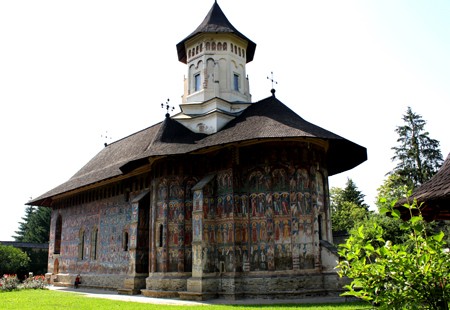Following the Ottoman conquest of Constantinople in 1453, the principality of Moldavia—today within the borders of northeastern Romania and the Republic of Moldova—emerged as a Christian frontier at the crossroads of western European, Slavic-Byzantine, and Ottoman cultures. From the second half of the fifteenth century onward, this marginal region of the Byzantine Empire took on a central role in the continuation and refashioning of Byzantine artistic traditions. Continual contacts with diverse cultures also resulted in the local assimilation of select elements from distinct visual traditions, often with surprising results. This eclecticism is most evident in the fortified Orthodox monastic churches (or
Current scholarship lacks a critical framework for the evaluation of the Moldavian monastic churches. The monuments have largely been studied by local historians who have formally examined the buildings from archaeological and iconographical standpoints but have not used the resulting material to broach larger issues of cultural contact and assimilation. Western European and North American scholars have paid little attention to the visual culture of this region. To a large degree, this neglect is the consequence of twentieth-century politics. The Iron Curtain created both actual and ideological barriers, rendering certain kinds of cultural and interpretive studies and scholarly exchanges difficult. The evidence, I argue, suggests that the artistic production of Moldavia, and of Central and Eastern Europe more generally, should be analyzed through cultural connections, historically grounded methodologies, and more nuanced interpretive strategies.
The visual and architectural rhetoric of the Moldavian churches reveals fascinating discontinuities among the forms and image programs of these buildings, presenting an unprecedented mixture of Western (Gothic), Byzantine, Slavic, and even Islamic architectural and iconographic features alongside local developments. Whereas the churches conform to an Orthodox plan and have dimly lit interiors with image cycles that emulate Byzantine stylistic and iconographic patterns, their exteriors present architectural features adopted from Western models, such as pointed arches with Gothic curvilinear tracery and large buttresses against the walls. Moreover, hundreds of brightly colored scenes in multiple registers wrap completely around the exteriors. These represent Christological, Mariological, and hagiographical stories alongside full-length depictions of saints, prophets, martyrs, and angels. Interspersed with the religious imagery are depictions of historical moments such as the celebrated victory of Emperor Constantine the Great against Maxentius at the Battle of the Milvian Bridge in 312 and the siege of Constantinople in 626 by the Avars and the Persians. These powerful historical narratives—stories that recount divine aid—had particular resonances in Moldavia, given the Ottoman threat to the region’s independence, political stability, and religious identity in the first half of the sixteenth century, and thus received a place of distinction among the mural cycles of the monastic churches.
Two key chapters of my dissertation address the eclectic visual and architectural vocabularies of the Moldavian
The remaining four chapters engage with the architecture, image programs, and functions of the Moldavian churches in the context of religious politics and patronage, addressing dynastic and spiritual concerns of patrons in the monastic milieu, spatiotemporal experience, cultural memory, and notions of history. My research also considers the extent to which the Moldavian monasteries contributed to the formulation of a new sacred landscape in this eastern Carpathian region at a crucial moment in Christian history, while presenting visually concrete and critical responses to the events of 1453; to 1492, predicted as the end of the world by the Eastern Orthodox Christians; and even to the Reformation unfolding in the West in the early decades of the sixteenth century.
